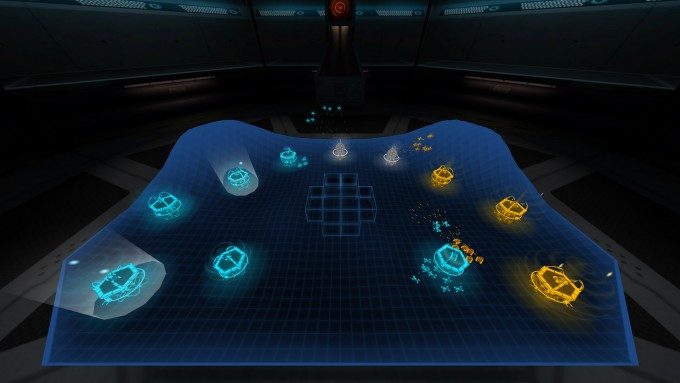If you’re the sort of person that played the forerunners of the real-time strategy genre, like the ’90s PC classic Command & Conquer (1995), you’ll be pleasantly surprised with Tactera, a fast-paced mobile RTS game today released for Gear VR. Although it’s missing the flash and vast number of unit/base options of its spiritual predecessors, don’t let the apparent simplicity fool you. The game is a real study in balance.
Tactera Details:
Official Site
Developer: E McNeill
Available On: Gear VR (‘Coming soon to Rift and other platforms’)
Reviewed On: Gear VR (Note 4)
Controller: Optional
Release Date: May 31st, 2016
Indie developer E McNeill, creator of the award-winning Gear VR strategy game Darknet, first created the concept of Tactera for the Oculus Mobile VR Jam in early 2015. Now out for $9.99 on the Gear VR store, Tactera is definitely money well spent for RTS lovers looking for anything from a quick 10 minute skirmish, an hour-long campaign, or a lengthy duel with a human foe through online multiplayer—all in an utterly cool futuristic war room.
Playing through the campaign, you’re presented with something akin to a simplified Risk board. This is the meta-game, so to speak, and your object is to move your tank icons from each hexagonal space and enter enemy territory where you’re automatically given a number of battles to command. Choose wisely though, because depending on how many tank icons you were able to move up from your starting position, some battles are seemingly hopeless—making it more about knowing which battles to engage in, and which to accept as inevitable losses.
Entering into a battle, which displays anywhere from a 5% to 95% possibility of winning, you finally get a whack at the holographic tabletop, where you are given the opportunity to select 3 out of a total of 12 possible unit classes. In traditional RTS style, all of the toy-sized units have their own balances between speed, firepower, production rate, etc. Again, choosing wisely is the name of the game, because you only have 3 classes at your disposal, and you can’t select the same units twice in a row!
Sounds complicated? It really isn’t, not when you get into the game. Once you’ve picked a battle with a decent win percentage, and allocated your unit classes, you’ll soon be frantically ordering units around the tabletop, capturing enemy bases (which are fixed around the map), and assigning new units to balance the tide of the battle. Oh, and the best part? No tiberium (or any other type of resource to collect).
If my description wasn’t glowing enough, I’ll just come out and say it. I really like Tactera. It dispenses with what I consider mostly useless, like story mode and in-game currency, making it seem like a no-nonsense affair that you can pick up while you’re on the train and put back down when you’ve arrived at your destination—all on in a beautifully rendered war room tabletop with Micro Machine toys shooting at each other (just make sure you’ve finished your match before you pull your phone out, as there’s no mid-game save feature). I do however miss the ability to deploy bases, but I understand McNeill’s choice to use the map’s pre-established base hotspots, effectively making it more chess-like than the free-for-all map mechanic of most RTS games.

Speaking of playing in a train: you’re going to be flailing your head around quite a bit playing Tactera. I’m a notorious opponent of gaze-based selection, mostly because I believe the human neck makes a very poor pointing device. While I might very well have a weak pencil neck, there’s actually plenty of elements to click on and the pace is fast enough, so you tend not to notice so much. I still prefer to not use my neck as a fine pointer, but there’s little else you can do with Gear VR games without natural input devices.
That said, I sat down for a good hour trying to beat the computer in campaign mode, and honed my skills in skirmish mode on a number of obstacle-laden maps. As I was exploring the game prior to its official release the online mode wasn’t well populated, though I would have relished in the chance to be brutally beaten by a real, randomly matched opponent. Sadly, voice chat in multiplayer is not supported.
Last but not least is the music. Often taking a back seat to a game, Tactera’s driving soundtrack really pushed my Red Alert (1996) nostalgia buttons of playing as a kid. Even if it doesn’t have the same production value of the original scores, which feature a ripping guitar solo, the effect is largely the same—something I can basically say for the entire game. It’s not Command & Conquer, but I can’t help but feel the unabashed love for the series in what I can firmly call a spiritual successor of a different stripe.
 We partnered with AVA Direct to create the Exemplar Ultimate, our high-end VR hardware reference point against which we perform our tests and reviews. Exemplar is designed to push virtual reality experiences above and beyond what’s possible with systems built to lesser recommended VR specifications.
We partnered with AVA Direct to create the Exemplar Ultimate, our high-end VR hardware reference point against which we perform our tests and reviews. Exemplar is designed to push virtual reality experiences above and beyond what’s possible with systems built to lesser recommended VR specifications.










